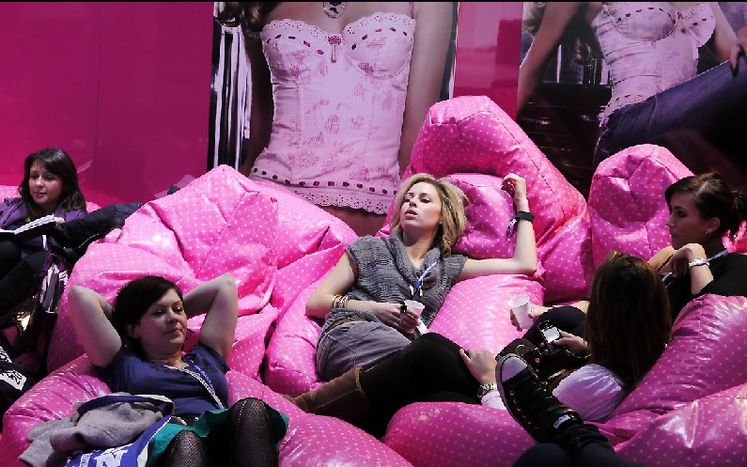
Ties and tees: three innovative fashion initiatives from Ljubljana, Lille and Berlin
Published on
Between 20 - 22 January, the historic Berlin-Tempelhof airport compound served as the venue of Bread and Butter, the most prominent trade fair for urban and streetwear, for the second year in a row. We pick tie manufacturers, T-shirt street fashion and an eco-sports label as top of the crop
The L.O.C.K. (‘Labels of Common Kin’) area is a hangar in the far west of the former airport compound which also serves as the heart of the Bread and Butter trade fair 2010. The idea behind ‘The Original’, which is the motto of the fair this year, is nowhere more present than here. Director Karl-Heinz Müller relocated the fair to Berlin in summer 2009 after years in Barcelona. The traditional aspect of new luxury, he says, is that consumers like history. They like authenticity and want to know where things come from. Tradition and handcraft are more important than short-lived trends, as the following three initiatives show.
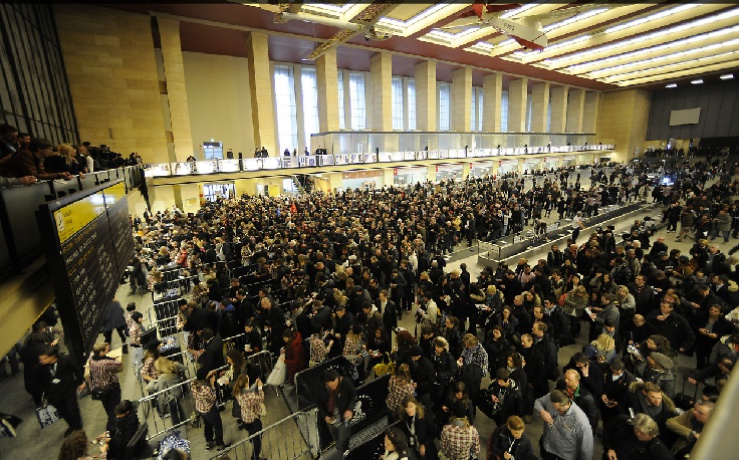
1. Edsor Kronen (Berlin): you in the 1920s
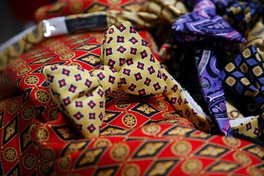 ‘Just feel that!’ A young blond man in prominent glasses and a red tie grasps energetically into a pile of dazzlingly bright material before letting it fall through his hands. ‘All pure Italian silk. You can feel how alive it is!’ Jan-Henrik M. Scheper-Stuke, 27, has been business director of Edsor Kronen, a real Berlin institution, since the new year. The firm has produced ties, cravats and scarves since 1909. Its heydey was in the golden twenties, a time in which much value was laid on elegant clothing. Today the enterprise wants to transport customers back into this magical decade. All articles are handmade. The silk is designed and cut in Germany. The enterprise has only thirty employees. Their customers range from private purchasers to large German chains. But is such a method of production actually cost-effective in these times of globalisation?
‘Just feel that!’ A young blond man in prominent glasses and a red tie grasps energetically into a pile of dazzlingly bright material before letting it fall through his hands. ‘All pure Italian silk. You can feel how alive it is!’ Jan-Henrik M. Scheper-Stuke, 27, has been business director of Edsor Kronen, a real Berlin institution, since the new year. The firm has produced ties, cravats and scarves since 1909. Its heydey was in the golden twenties, a time in which much value was laid on elegant clothing. Today the enterprise wants to transport customers back into this magical decade. All articles are handmade. The silk is designed and cut in Germany. The enterprise has only thirty employees. Their customers range from private purchasers to large German chains. But is such a method of production actually cost-effective in these times of globalisation?
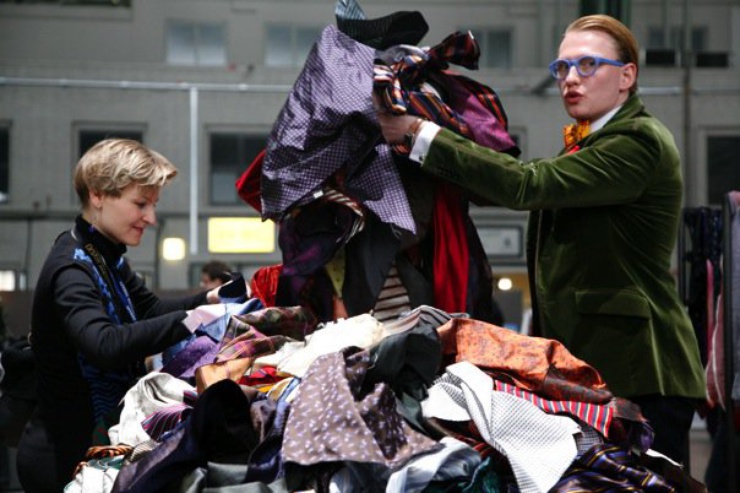
'Quality is always worth it,' says Scheper-Stuke optimistically. The firm has even survived the crisis pretty well, with sales remaining almost constant. 'It is in such uncertain times that the desire for warmth, constancy and authenticity is particularly strong,' explains the skilled business economist. 'People have had enough of mass consumption and the increasing lack of variety in all areas of products. They search for something with which they can identify. Something about which they can say: that's me!'
II. Wannabesociety (Ljubljana): you in one word
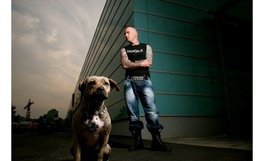 Wannabesociety (WNBS) are the 'first and only producers from Slovenia,' reveals Tanja Kranjec proudly. In comparison to the young Berliner before her, Tanja is inconspicuously dressed – you might almost want to say mutedly. Yet her black and white polka dotted top suits the background wonderfully: white shirts printed with words like happy, fresh or headbanger hang behind her; there are no logos in sight. ‘We don't make fashion in the classic sense of the word,’ Tanja makes clear right at the start. ‘It's more of a concept, a philosophy. The idea is that customers choose from a word bank at wannabesociety.com, the word which best describes them. A wish, an intention, an aim. The word then graces T-shirts, long sleeved tops, tracksuit trousers or bikinis, and it's all exclusively in black and white. Anything else would detract from the message.’ The creators call this ‘invisible design’.
Wannabesociety (WNBS) are the 'first and only producers from Slovenia,' reveals Tanja Kranjec proudly. In comparison to the young Berliner before her, Tanja is inconspicuously dressed – you might almost want to say mutedly. Yet her black and white polka dotted top suits the background wonderfully: white shirts printed with words like happy, fresh or headbanger hang behind her; there are no logos in sight. ‘We don't make fashion in the classic sense of the word,’ Tanja makes clear right at the start. ‘It's more of a concept, a philosophy. The idea is that customers choose from a word bank at wannabesociety.com, the word which best describes them. A wish, an intention, an aim. The word then graces T-shirts, long sleeved tops, tracksuit trousers or bikinis, and it's all exclusively in black and white. Anything else would detract from the message.’ The creators call this ‘invisible design’.
Extreme individualists, who can't find the right word even in the list of the 1309 words in the online databank, also have the opportunity to submit their own suggestions. Once accepted, the word gets taken into the so-called word chart. The most popular word happens to be loved. Yet the concept of Wannabesociety is not exhausted in the printing of T-shirts. 'The community aspect is important,' explains Tanya. The label, formed in 2007, now has members stretching from New York to Kuala Lumpur. ‘Our dream is to unite creative people from all over the world,’ she finishes. ‘People for whom content is more important than form.’
III. Sébola (Lille): you 'feel good'
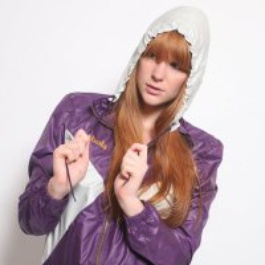 Fashion isn't just aesthetic. Stylish, functional and ecological, thirtysomething director and co-founder Loïc Pollet describes his philosophy as being ‘fashion for the soul’ as he leans casually by his sport shirts and jogging trousers. He wears a gold medallion around his neck: 'Sustainability makes the whole world into a winner,' he says. The ‘é’ in Sébola is meant to bring the French origins of the enterprise to mind, and stands for eco-design – a global ecological approach whose aim is to reduce air and water pollution and to take care of natural resources. In layman's terms, that means breathable sports clothing made from recycled polyester, 'lifestyle clothing' from 100% organic cotton. The materials are cultivated in Turkey and shipped to France in order to reduce the use of natural resources and production of greenhouse gases. During the manufacturing process, Sébola also values local industry; the articles are finished in Roubaix in northern France, known as the centre of the country’s textile industry. In France the label, which sells its products online and in a Parisian boutique, is already causing a stir. It was recognised at the ethical fashion show 2008 for its ecological engagement. In the last four or five years ecological thinking has become accepted even in the fashion industry, claims Loïc. ‘Certainly Germany and Scandanavia are already way ahead of us. It will still take a while in France before people realise that it is more important to feel good than to look good.’
Fashion isn't just aesthetic. Stylish, functional and ecological, thirtysomething director and co-founder Loïc Pollet describes his philosophy as being ‘fashion for the soul’ as he leans casually by his sport shirts and jogging trousers. He wears a gold medallion around his neck: 'Sustainability makes the whole world into a winner,' he says. The ‘é’ in Sébola is meant to bring the French origins of the enterprise to mind, and stands for eco-design – a global ecological approach whose aim is to reduce air and water pollution and to take care of natural resources. In layman's terms, that means breathable sports clothing made from recycled polyester, 'lifestyle clothing' from 100% organic cotton. The materials are cultivated in Turkey and shipped to France in order to reduce the use of natural resources and production of greenhouse gases. During the manufacturing process, Sébola also values local industry; the articles are finished in Roubaix in northern France, known as the centre of the country’s textile industry. In France the label, which sells its products online and in a Parisian boutique, is already causing a stir. It was recognised at the ethical fashion show 2008 for its ecological engagement. In the last four or five years ecological thinking has become accepted even in the fashion industry, claims Loïc. ‘Certainly Germany and Scandanavia are already way ahead of us. It will still take a while in France before people realise that it is more important to feel good than to look good.’
The next Bread and Butter takes place between 7 and 9 July 2010
Images: ©breadandbutter.com; Edsor Kronen; WNBS; Sébola all via Facebook/ Videos: ©sebolacollection; wannabesociety via Youtube
Translated from Mode, Bread & Butter: Traditionsbewusste Labels - neuer Luxus



